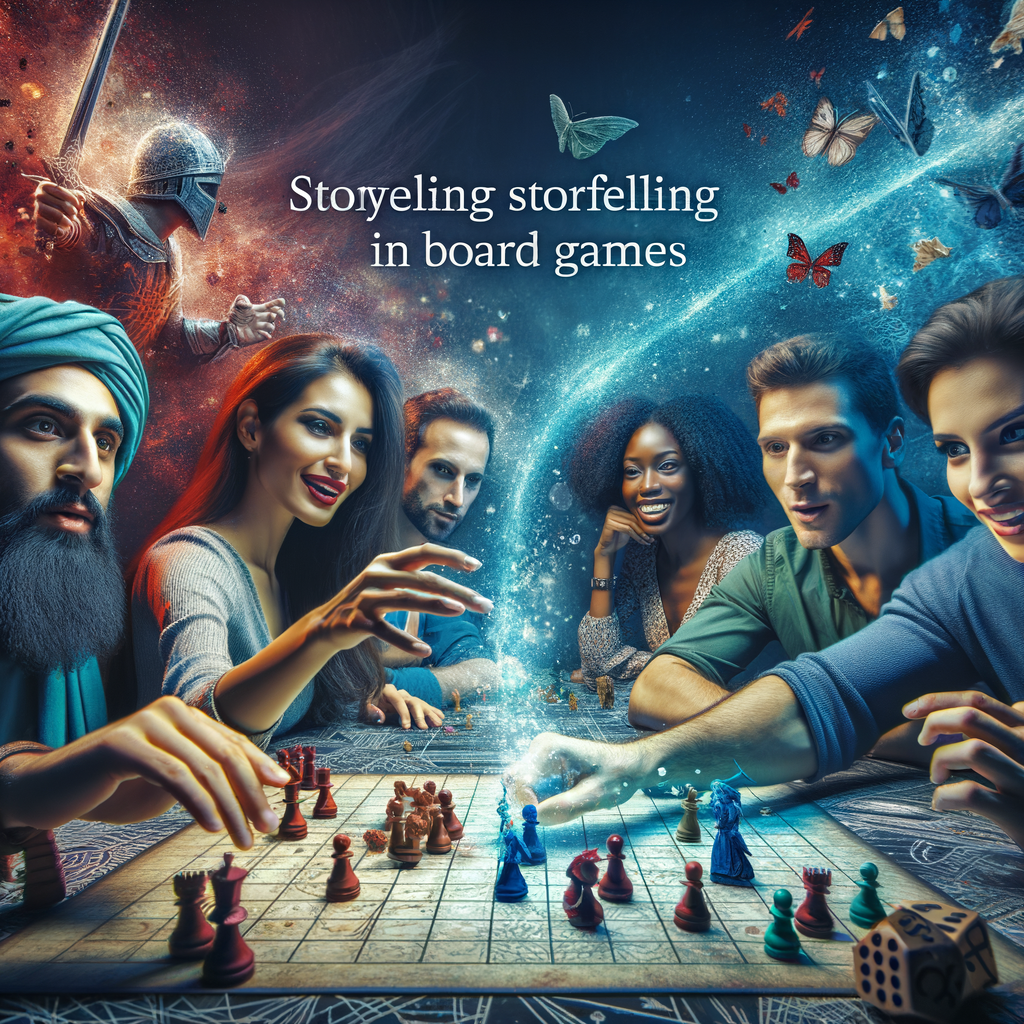Introduction: The Power of Storytelling in Role-Playing Board Games
Storytelling is a powerful tool that has been used for centuries to pass down knowledge, culture, and values. In the world of role-playing board games (RPGs), storytelling takes on a unique and significant role. It is not just a way to entertain, but it also shapes the gaming experience, making it more immersive and engaging. In this blog post, we will delve into the importance of storytelling in RPG board games and how it influences the gaming experience.
- Understanding the Importance of Storytelling in RPG Board Games
Storytelling in RPG board games is not just about creating a backdrop for the game. It is an integral part of the game itself. The story provides the context and the motivation for the players. It sets the stage, defines the characters, and determines the objectives. It is the story that makes the game more than just a series of actions or decisions. It gives the game a purpose and a direction. It makes the game meaningful.
- How Storytelling Shapes the Gaming Experience
Storytelling shapes the gaming experience in several ways. First, it creates a sense of immersion. When players are engrossed in a compelling story, they become more invested in the game. They care about the characters and the outcome of the game. Second, storytelling adds depth to the game. It adds layers of complexity and richness that make the game more interesting and challenging. Finally, storytelling makes the game more memorable. The best games are the ones that tell a great story, the ones that stay with you long after you have finished playing.
Storytelling in RPG board games is a powerful tool that can transform a simple game into an unforgettable adventure. It is what makes RPG board games so captivating and enduring. So, whether you are a game designer or a player, understanding the power of storytelling in RPG board games can enhance your appreciation of these games and elevate your gaming experience.
The Art of Storytelling in Board Games
 Storytelling is a powerful tool that can make any board game more engaging and immersive. When it comes to role-playing games (RPGs), the narrative element is even more crucial. It serves as the backbone of the game, guiding players through a unique and captivating journey.
Storytelling is a powerful tool that can make any board game more engaging and immersive. When it comes to role-playing games (RPGs), the narrative element is even more crucial. It serves as the backbone of the game, guiding players through a unique and captivating journey.
Role-Playing Games and the Narrative Element
Role-playing games are a special breed of board games. They rely heavily on storytelling, allowing players to step into the shoes of various characters and navigate through intricate plots. Let’s delve deeper into the narrative structure of these games and see how it enhances the role-playing experience.
- Exploring the narrative structure in RPG board games
In RPG board games, the narrative structure is often complex and multi-layered. It’s not just about moving pieces on a board; it’s about embarking on a journey. The story unfolds as players make choices, face challenges, and interact with the game world. This dynamic narrative structure keeps players engaged and invested in the game. For example, in the popular RPG board game Dungeons & Dragons, the narrative is driven by the players’ decisions, resulting in a different adventure every time you play.
- How narratives enhance the role-playing experience
The narrative in RPG board games is not just a backdrop; it’s an integral part of the gameplay. It provides context for the players’ actions and decisions, making the game more meaningful and immersive. A well-crafted narrative can evoke emotions, create tension, and inspire players to think strategically. It can transform a simple board game into an epic adventure. For instance, in the RPG board game Gloomhaven, the rich narrative adds depth to the gameplay, making each decision feel significant and each victory more satisfying.
In conclusion, the art of storytelling in RPG board games is a fascinating topic. It’s a testament to the power of narrative in enhancing the gaming experience. So, next time you play an RPG board game, take a moment to appreciate the intricate narrative woven into the gameplay.
Storytelling Techniques in Board Games
Storytelling in board games is an art that transforms the gaming experience into a captivating journey. It employs several techniques to create a compelling narrative that engages players and enhances their immersion in the game. Let’s delve into three key storytelling techniques used in board games.
Use of Characters and Plot
Characters and plot are the heart and soul of any story. In board games, characters are often represented by game pieces, cards, or figures, each with their own unique abilities, traits, and backstories. The plot is the overarching narrative that drives the game, providing a context for the players’ actions and decisions. For example, in the game Dungeons & Dragons, players assume the roles of characters embarking on epic quests, with the plot unfolding based on their choices and actions.
World-Building and Setting
World-building is the process of creating an imaginary world where the game takes place. This includes the physical environment, culture, history, and social norms of the game world. The setting provides a backdrop for the story, influencing the plot and character development. A well-crafted world can transport players to another realm, enhancing their immersion in the game. For instance, the board game Catan is set on an uncharted island, with players competing to establish the most successful colony.
Conflict and Resolution
Conflict is a crucial element of storytelling, creating tension and driving the narrative forward. In board games, conflict often arises from competition between players, challenges posed by the game, or obstacles that players must overcome to achieve their goals. The resolution of these conflicts provides a sense of accomplishment and progression, making the game more engaging and rewarding. For example, in the game Risk, players engage in strategic conflicts to conquer territories, with the game’s resolution achieved when one player dominates the world.
In conclusion, the use of characters and plot, world-building, and conflict and resolution are key storytelling techniques in board games. They serve to create a rich narrative that enhances the gaming experience, making each game a unique and memorable adventure.
The Impact of Storytelling in Role-Playing Games
Storytelling is a powerful tool in role-playing games (RPGs). It can transform a simple game into an immersive experience, captivating players and keeping them engaged for hours on end. Let’s delve into how storytelling enhances player engagement in RPGs.
Enhancing Player Engagement
Engagement is a key factor in the success of any game. The more engaged players are, the more likely they are to continue playing and even recommend the game to others. Storytelling plays a crucial role in this aspect.
- How storytelling keeps players invested in the game
Storytelling in RPGs creates a rich and immersive world that players can lose themselves in. It gives players a sense of purpose and direction, making them feel like they are part of something bigger than themselves. This emotional connection keeps players invested in the game, eager to see how the story unfolds and how their actions can influence the outcome.
- Case study: The success of story-driven board games
One example of the success of story-driven RPGs is the board game Gloomhaven. This game has been praised for its deep and engaging storyline, which keeps players coming back for more. According to a survey by BoardGameGeek, Gloomhaven is consistently ranked as one of the top board games, demonstrating the power of storytelling in enhancing player engagement.
In conclusion, storytelling in RPGs is not just about creating a compelling narrative. It’s about creating an immersive world that players can connect with on an emotional level, keeping them engaged and invested in the game. As seen in the case of Gloomhaven, a strong storyline can significantly contribute to a game’s success.
Boosting Imagination and Creativity
Storytelling in role-playing board games does more than just entertain. It plays a critical role in stimulating imagination and encouraging creative problem-solving. Let’s delve into these aspects.
- Role of storytelling in stimulating imagination
Storytelling is a powerful tool that can transport us to different worlds, making us see, hear, and feel things that are beyond our immediate reality. In role-playing board games, storytelling serves as the backbone of the game, providing a context and a world in which the players can immerse themselves. This immersion stimulates the imagination, as players visualize the game’s narrative and their characters’ actions.
For instance, in the popular role-playing game Dungeons & Dragons, players are presented with a rich narrative filled with intricate details about the game world. This narrative acts as a catalyst, sparking the players’ imagination and allowing them to visualize their characters’ adventures.
- How storytelling encourages creative problem-solving
Storytelling in role-playing games also encourages creative problem-solving. The narrative often presents players with challenges or obstacles that they must overcome to progress in the game. These challenges require players to think creatively, coming up with innovative solutions based on the resources available to them within the game’s narrative.
For example, in the game The Lord of the Rings: The Card Game, players are faced with a variety of challenges that they must overcome using the cards in their deck. The narrative context of these challenges encourages players to think creatively, devising strategies that align with the story and their characters’ abilities.
In conclusion, storytelling in role-playing board games is a powerful tool for boosting imagination and encouraging creative problem-solving. It provides a rich narrative context that stimulates the imagination and presents challenges that require creative solutions. So, the next time you play a role-playing board game, take a moment to appreciate the storytelling and the ways it enhances your gaming experience.
Role-Playing Game Narratives: Examples of Excellence
Let’s delve into the captivating world of role-playing games (RPGs) and explore some of the most compelling narratives that have left a lasting impact on players worldwide. We will examine popular RPG board games known for their immersive storytelling and highlight the key takeaways from these successful narratives.
- Examining popular RPG board games with compelling narratives
Role-playing games are renowned for their ability to transport players into different worlds, thanks to their intricate narratives. Let’s take a look at a few examples of RPG board games that have mastered the art of storytelling.
Dungeons & Dragons is a classic example of a board game with a compelling narrative. The game, which has been around since the 1970s, allows players to create their own characters and embark on epic quests in a fantasy world. The success of Dungeons & Dragons lies in its ability to create a rich, immersive world that players can interact with and shape through their actions. You can learn more about this game here.
Another example is Gloomhaven, a game that combines tactical combat with an ongoing narrative. In Gloomhaven, players take on the role of adventurers with unique abilities and personal quests. The game’s narrative unfolds through a series of scenarios, with players’ decisions affecting the course of the story. More about Gloomhaven can be found here.
- Key takeaways from successful storytelling in these games
So, what can we learn from the storytelling in these popular RPG board games? Here are some key takeaways:
1. Player Agency: Both Dungeons & Dragons and Gloomhaven give players a significant amount of control over the story. This sense of agency makes players feel more invested in the game and its narrative.
2. Rich World-Building: These games create immersive worlds filled with interesting characters, locations, and lore. This level of detail helps players feel like they’re part of a living, breathing world.
3. Ongoing Narrative: The narrative in these games isn’t static. It evolves based on players’ decisions, making each playthrough unique and engaging.
By incorporating these elements into their narratives, RPG board games can create memorable experiences that keep players coming back for more.
Conclusion: The Future of Storytelling in RPG Board Games
As we venture further into the 21st century, the world of RPG board games continues to evolve and innovate. The future of storytelling in these games is bright, with emerging trends and immense potential shaping the landscape. Let’s delve into what the future holds.
- Emerging trends in board game storytelling
One of the most exciting trends in RPG board games is the increasing use of immersive storytelling. This approach involves players more deeply in the game, making them feel like they are part of the narrative. For example, games like Gloomhaven and Pandemic Legacy have been praised for their rich, evolving narratives that change based on player decisions. Gloomhaven, in particular, has been lauded for its innovative use of branching storylines, creating a unique experience for each game session.
Another trend is the rise of cooperative storytelling. In these games, players work together to create a shared narrative, often leading to unexpected and exciting developments. This trend highlights the power of collaboration and creativity in RPG board games.
- The potential of storytelling in shaping the future of RPG board games
Storytelling has the potential to revolutionize RPG board games. As technology advances, we may see more games incorporating digital elements to enhance their narratives. Imagine a game where your actions are reflected in a companion app, altering the story in real-time. The possibilities are endless.
Moreover, as players continue to crave more immersive and personalized experiences, the demand for innovative storytelling will only increase. This could lead to a new era of RPG board games, where the narrative is just as important as the gameplay mechanics.
In conclusion, the future of storytelling in RPG board games is exciting and full of potential. With emerging trends like immersive and cooperative storytelling, along with the increasing integration of technology, we can expect to see more innovative and engaging narratives in the years to come. As we continue to explore and push the boundaries of what’s possible in this medium, one thing is clear: the story is just beginning.



